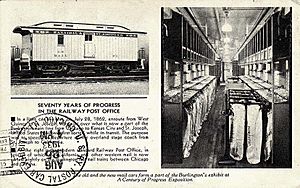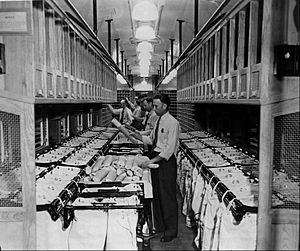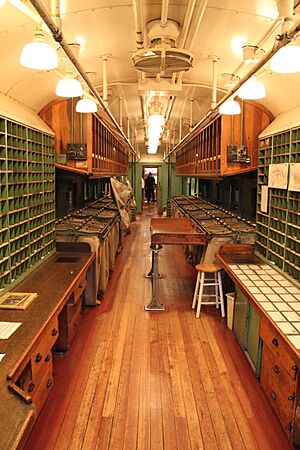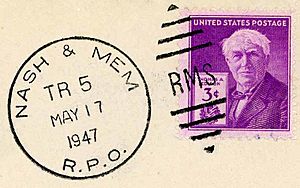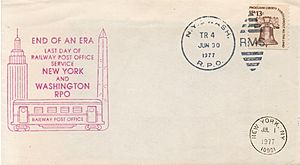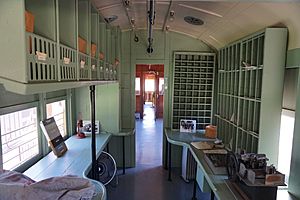Railway post office facts for kids
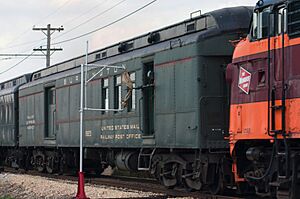
A railway post office, often called an RPO, was a special train car. It traveled with passenger trains. Its main job was to sort mail while the train was moving. This helped mail get to people faster. RPOs had highly trained postal workers. Passengers were not allowed inside these cars. In the UK and Ireland, they were called Travelling Post Offices (TPO).
From the mid-1800s, many American railroads earned a lot of money. They had deals with the U.S. Post Office Department. They carried mail on fast passenger trains. The Railway Mail Service made rules for how RPOs should look. Sometimes, trains even ran passenger routes that lost money. But they made up for it by carrying mail!
Contents
How Mail Trains Started
The very first time mail was officially carried by train was in November 1830. This happened in the UK. The General Post Office used special train cars on the Liverpool and Manchester Railway. Sorting mail while traveling first began in the UK in 1838. This was on the Grand Junction Railway.
In the United States, some say mail was first carried on a train in 1831. This was on the South Carolina Rail Road. The mail was sorted before and after the trip. Other stories say the first official deal to carry mail regularly was in 1834 or 1835. This was with the Baltimore and Ohio Railroad. On July 7, 1838, the United States Congress made all railroads official mail routes. Canada started similar services in 1859.
The First Railway Post Offices
The idea of sorting mail on a train started in the United States on July 28, 1862. They used changed baggage cars on the Hannibal and St. Joseph Railroad. This railroad also carried the first letter for the Pony Express. Special RPO cars were built for this line a few weeks later. Their goal was to sort mail for a stagecoach leaving soon after the train arrived. This service lasted about one year.
The first permanent Railway Post Office route began on August 28, 1864. It ran between Chicago, Illinois, and Clinton, Iowa. This service was different. Mail was sorted for and picked up from every post office along the way. It also handled mail for bigger post offices beyond the route's end.
George B. Armstrong, an assistant postmaster in Chicago, had the idea. He wanted mail to be processed while on the train. With help from important people, he was allowed to try his idea.
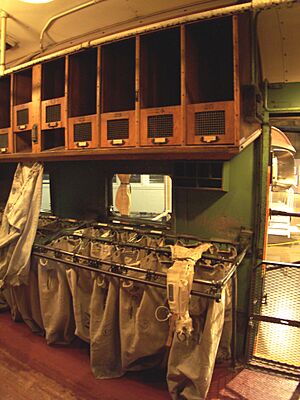
In 1869, the Railway Mail Service (RMS) officially started. It was led by George B. Armstrong. Its job was to handle mail transport and sorting on trains. Armstrong had been a supervisor in the Chicago post office. He had experimented with a converted mail car in 1864.
At first, RPO cars had solid wood furniture. But soon, their insides were changed. In 1879, an RMS worker named Charles R. Harrison created new equipment. His design used hinged, cast-iron parts. These could be folded out to hold mail bags, racks, and a sorting table. They could also be folded away completely. This made space for general baggage or other shipments. Harrison started a factory in Fond du Lac, Wisconsin in 1881 to make his design.
Mail Trains Across America
The Pacific Railroad Act was signed by President Lincoln on July 1, 1862. This law gave government money to build a railroad from the Missouri River to the Pacific Ocean. The main goal was to create a mail route across the western frontier. This law opened the door for government-funded railroad mail routes across America.
By the 1880s, RPO routes were on most passenger trains in the United States. A huge network of routes allowed mail to be moved very quickly. Up to a dozen clerks might work in one RPO car. Fewer were needed if part of the car carried already sorted mail or baggage.
Railway mail clerks had to train hard and pass many tests. They had to know every post office and train junction on their route. They also needed to know how to deliver mail in bigger cities. Tests checked how fast and accurately they sorted mail. If a clerk scored only 96% accuracy, they might get a warning! Even Interurban and streetcar systems sometimes had RPOs. For example, the Boston Elevated Railway car picked up mail around the city.
In the United States, RPO cars (also called mail cars or postal cars) could do most postal jobs. First-class mail, magazines, and newspapers were sorted. They were also cancelled (stamped) if needed. Then they were sent to post offices in towns along the route. Registered mail was also handled. The foreman in charge had to carry a pistol to prevent mail theft.
Making RPO Cars Better
RPO clerks had tough jobs, both physically and mentally. So, the Railway Mail Service wanted all RPO cars to have standard layouts and equipment. The first plans were published in 1885. The RMS also pushed for better lighting. This helped clerks see addresses on the mail. They improved lamps in the 1880s. Then they stopped using oil lamps in the 1890s. They started trying electric lights in 1912.
The safety of clerks was also very important. The first detailed reports on work injuries came out in 1877.
Car Colors and Strength
In the late 1800s, most RPO cars looked similar. They were usually white with buff, red, or blue trim. This made them stand out from other train cars. By the 1890s, this changed. Railroads started painting RPO cars to match the rest of their passenger trains. One RPO car shown at the 1893 World's Columbian Exposition in Chicago was one of the last white ones.
As passenger cars improved, so did RPO cars. Early RPO cars were built like light baggage cars. This sometimes led to terrible accidents for RMS workers. From 1900 to 1906, about 70 workers died in train wrecks while on duty in RPOs. This led to calls for stronger steel cars.
The RMS made its first rules for car design in 1891. In 1912, they set strength rules for new cars. They wanted car builders to use steel for the main parts of the cars. Each car had to withstand a force of at least 400,000 pounds. This was doubled to 800,000 pounds in 1938. In 1945, the rules were made even stronger. They said aluminium could not be used for main parts. They also required strong end posts to prevent cars from crushing into each other in a crash. Car makers used these rules for all their passenger cars.
The Mail Hook
Most RPO cars had a cool feature: a hook! This hook could grab a leather or canvas mail pouch. The pouch would be hanging on a track-side mail crane in smaller towns where the train didn't stop. The first US patent for this hook was given in 1867.
Imagine the train going 70 miles per hour or more! A postal clerk would have a mail pouch ready to send out. As the train passed the station, the catcher arm would swing out. It would grab the hanging mail pouch. At the same time, the clerk would kick the outgoing mail pouch out of the car. They had to kick it far enough so it wouldn't get sucked back under the train! The mail pouch had a strap around the middle. It was tightened and had equal weight on both ends. This kept it from falling off the hook. Local post office workers would then pick up the pouches.
In the 1950s, the Budd Company made self-propelled diesel cars called RDCs with RPO sections. These were bought by many railroads, including the New York Central and Canadian Pacific Railway.
-
Chicago, Burlington and Quincy Railroad #1923, an RPO at the Illinois Railway Museum.
-
The inside of an RPO at the National Railroad Museum.
Mail Stamps from the Train
Most RPO cars had a mail slot on the side. You could drop off mail there, like a mailbox, when the train stopped. People who wanted the fastest delivery would bring their letters to the station. They knew it would likely arrive overnight.
Mail sent this way got a special stamp. It was like a stamp from a local post office. But it showed the train number, the start and end cities of the RPO route, the date, and "RMS Railway Mail Service" or "PTS Postal Transportation Service". Collecting these stamps is a hobby for many stamp collectors.
The Railway Mail Service was part of the Post Office Department from 1864 to 1948. It was renamed the Postal Transportation Service in 1948 and lasted until 1960. After 1960, other groups managed mail routes.
The End of Mail Trains
At their peak, RPO cars were on over 9,000 train routes. This covered more than 200,000 miles in North America. Most of this service was one or more RPO cars at the front of passenger trains. But many railways ran whole trains just for mail between big cities. These trains often carried 300 tons of mail every day!
After 1948, the RPO network started to shrink. But it was still the main way mail was moved and sorted between cities. In 1948, there were 794 RPO lines. By 1962, only 262 RPO routes were still running.
In 1942, the Post Office Department tried a road version of the RPO. These highway post office (HPO) vehicles were meant to help RPOs. But in the 1950s and 1960s, HPOs often replaced RPO cars when passenger train service stopped.
In September 1967, the Post Office Department made a big change. They stopped all "mail by rail" contracts. They decided to send all first-class mail by air and other mail by truck. This greatly hurt passenger train companies. For example, the Santa Fe railroad lost $35 million a year. This led to many passenger train routes ending.
After 113 years, the last railway post office train ran on June 30, 1977. It traveled between New York and Washington, D.C.. The very last route with the RPO name was actually a boat! This Boat Railway Post Office operated on Lake Winnipesaukee in New Hampshire. It ran until September 30, 1978.
Preserving Mail Train History
Many RPO cars have been saved and are now in railroad museums across North America. Some of these cars can even still run! In 1933, the Chicago, Burlington and Quincy Railroad rebuilt one of its baggage cars. It looked like the first RPOs used in 1862. This car was shown in many cities. It is now at the Patee House Museum in St. Joseph, Missouri.
The Minnesota Transportation Museum (MTM) has Northern Pacific #1102. This is a 1914 Mail RPO car. It's a "combine" car, meaning it has sections for the RPO, express packages, and twenty seats for passengers. It is currently the only RPO car known to be working and certified to run on commercial tracks. The Osceola and St. Croix Valley Railway operates this car. It even "catches the mail on the fly" as part of its regular trips.
For the 40th anniversary of RPO service ending, the Minnesota Transportation Museum displayed #1102. This was at Saint Paul Union Depot for National Train Day in May 2017. A special train, including #1102, carried commemorative envelopes and cards. These were sent across the United States.
Steamtown National Historic Site in Scranton, Pennsylvania, has RPO car #1100. It belonged to the Louisville & Nashville railroad. It's an all-steel car built in 1914.


